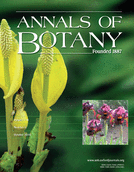Background and aims Miscanthus is a genus of perennial C4 grasses native to East Asia. It includes the emerging ligno-cellulosic biomass crop M. ×giganteus, a hybrid between M. sinensis and M. sacchariflorus. Biomass yield and cold tolerance are of particular interest in Miscanthus, given that this crop is more temperate adapted than its C4 relatives maize, sorghum and sugarcane.
Methods A plant exploration was conducted in eastern Russia, at the northern extreme of the native range for Miscanthus, with collections including 174 clonal germplasm accessions (160 M. sacchariflorus and 14 M. sinensis) from 47 sites. Accessions were genotyped by restriction site-associated DNA sequencing (RAD-seq) and plastid microsatellites.
Key Results Miscanthus sinensis was found in maritime climates near Vladivostok (43·6°N) and on southern Sakhalin Island (46·6°N). Miscanthus sacchariflorus was found inland at latitudes as high as 49·3°N, where M. sinensis was absent. Most M. sacchariflorus accessions were diploid, but approx. 2 % were tetraploids. Molecular markers revealed little population structure (Jost’s D < 0·007 among diploid groups) but high genetic diversity (expected heterozygosity = 0·14) within the collection of Russian M. sacchariflorus. Genome-wide association (GWA) analysis for traits measured at the collection sites revealed three M. sacchariflorus single nucleotide polymorphisms (SNPs) significantly associated with the number of stems per unit area, one with height and one with basal stem diameter; three were near or within previously described sorghum quantitative trait loci for related traits.
Conclusions This new Miscanthus germplasm collection from eastern Russia will be useful for breeding Miscanthus and sugarcane cultivars with improved adaptation to cold. Moreover, a strategy is proposed to facilitate the rapid utilization of new germplasm collections: by implementing low-cost SNP genotyping to conduct GWA studies of phenotypic data obtained at collection sites, plant breeders can be provided with actionable information on which accessions have desirable traits and alleles.
: Clark, L.V., et al.
: Annals of Botany
Publication Years: 2016
Genetic diversity
